Geoscience Reference
In-Depth Information
5.7.1.4
Eddy currents
Induction of eddy currents (see
Section 5.2.2.2
)
occurs
instantaneously and simultaneously with the variations in
the primary
thick bodies with 3D geometry may have several eddy
current systems created within them (
Fig. 5.71b
), which
tend to merge and reorientate in the body with time.
In reality, conductors in the geological environment are
often electrically heterogeneous. Variable mineralogy,
textures and pore contents produce electrical anisotropy
and inhomogeneity (see
Section 5.3
)
. Currents can be chan-
nelled through the more conductive parts of a heteroge-
neous conductor, and anisotropy will influence orientation
of flow paths. Also, multiple zones of higher conductivity in
a conductor have their own local eddy currents which may
merge at later times into a single current system, and
variations in body thickness and shape will affect the cur-
rent flow. For the case where the primary field is stronger
over a small part of a conductor, the eddy currents will flow
in that part of the body. The current system may then be
controlled by the geometry of the primary
field and in all of those conductors in the
subsurface where a component of the primary
field inter-
sects them perpendicularly. In accordance with Faraday
s
the stronger the eddy current induced. For the reasons
described in
Section 5.2.2.2
,
in a homogeneous equidimen-
sional conductor eddy currents
flow in closed circular
paths in the plane perpendicular to the
field causing them.
The extent to which this actually occurs depends on the
size, shape and electrical homogeneity of conductive zones
in the subsurface.
In contrast to the sheet-like bodies described above
which have only the dip plane in which the eddy currents
can flow, irrespective of the direction of the primary field
intersecting the body (
Fig. 5.71a
)
, in sphere-like bodies
with homogeneous conductivity the eddy current
circulation depends only on the direction of the primary
field (
Fig. 5.71b
). Changing the field direction by moving
the transmitter loop changes their orientation, i.e. a differ-
ent current system is set up. Even for a single loop position,
'
field rather than
the geometry of the whole conductor. The system of eddy
currents in a conductor is also in
uenced by the changing
eddy current
flows in overburden, conductive host rocks
and neighbouring conductors (see
Section 5.7.2
).
Initially, after the primary
field turn-off (or turn-on), the
eddy currents essentially
flow around the surface of the
conductor. With increasing time the eddy currents lose
energy mostly as heat due to the resistance of the con-
ductor and become weaker. This causes their magnetic
field to change, causing adjacent regions of the conductor
to experience a changing magnetic field. This creates a
mechanism for a diffusive inward migration of the circu-
lating current, the migration and decay being slower with
increasing conductivity.
Figure 5.72
illustrates this effect
for an electrically homogeneous conductor.
Since the decay of the eddy currents depends on the
body
a)
'
s electrical properties and its shape, and because they
Eddy currents
are
flowing in different parts of the target with increasing
time, analysing the associated changes in the secondary
magnetic
b)
field can provide information about the distribu-
tion of the conductivity. Soon after the primary
field is
turned off, the strength and
flow path of the currents are
dependent mainly on the shape of the conductor and not
its conductivity and, therefore, give good diagnostic infor-
mation about conductor geometry. At later time, the eddy
currents
flow deeper within the body and so depend on the
conductivity of its interior, although for bodies with very
high conductivity skin effects (see
Section 5.2.3.1
)
restrict
the current flow to chiefly the surface region. The diffusion
of eddy currents in conductivity structures common in the
geological environment is described in
Section 5.7.2
.
Figure 5.71
Orientation of eddy currents in homogeneous
conductors. The current system is oriented in the plane (a) of sheet-
like conductors, and (b) perpendicular to the primary
field direction
in spherical conductors.








































Search WWH ::

Custom Search